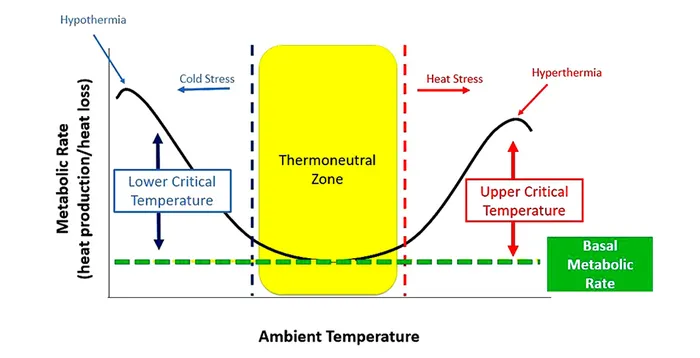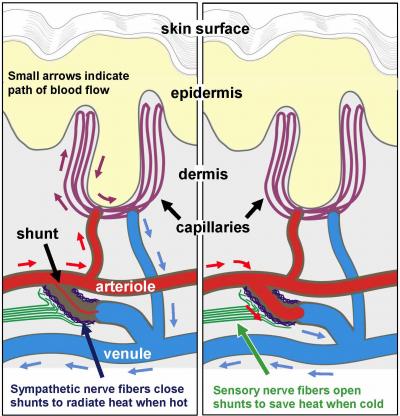Thermoregulation
1/13
There's no tags or description
Looks like no tags are added yet.
Name | Mastery | Learn | Test | Matching | Spaced |
|---|
No study sessions yet.
14 Terms
homeothermic endotherms
Animals that maintain a constant body temperature regardless of external conditions, usually through metabolic processes; maintain temp around 37F; about 70% of BMR for heat; heat loss must equal heat production
factors determining rates of heat loss
reducing heat loss by surface area, insulation/conductance, temperature difference or increase metabolic heat production by shivering thermogenesis or non-shivering thermogenesis and behavioral adaptations such as posture, goosebumps, blood flow changes, and choosing a warmer location
cold water adding to thermoregulatory demands
higher heat capacity of water causes heat to be transmitted away from the body 20-25xs faster than in air
decrease surface area
reduce heat loss
reducing surface area by tucking appendages
generally proportionally less surface area in marine mammals → low SA:volume ratio which means that for a given volume, large animals have less surface area through which to lose heat
decrease conductance/increase insulation
reduce heat loss
small animals use fur → dead tissue, oils, guard hairs, underfur; external; sea otter as densest fur at 130,000 hairs/cm²
large use blubber → fat and collagen; high lipids means high insulation
reduce temperature gradients
reduce heat loss
reduce difference between inside and outside temperatures → lower body temp?
regional heterothermy → different areas of the body have different temps (e.g. limbs colder than core)
thermoneutral zone (regulation within and outside of)
range of temps in which an endotherm can regulate body temp without changing its metabolic rate
Inside → change blood flow through skin (skin perfusion), piloerection, posture, location (no actual MR change)
Outside → cold = shivering thermogenesis (muscle twitching in opposing muscles and randomly timed to produce little movement but still heat) or non shivering thermogenesis (brown adipose tissue with high mitochondria is burned for heat) and hot = sweat or pant

contrast fur and blubber (advantages and disadvantages)
Fur (better overall)
advantages → better insulator than blubber (similar insulation w/ less mass over shorter distance), fur is dead (no nutrients necessary), skin maintained or near core body temp (heals better, no extra heat loss), lightweight, might be quick to change (shedding coat for new?)
disadvantages → needs grooming, can foul (e.g. oil spill damage), loses insulation at depth (pressure increase eliminates air trapped in fur), hard to dump heat (skin is covered, must rely on ‘naked’ thermal windows)
Blubber
advantages → withstands fouling, no grooming, no loss of insulation at depth, can be used as an energy store, easy heat dumping (exposed skin makes diversion of blood easy → cold divert blood away from skin, hot divert to skin)
disadvantages → skin is at lower temp than optimal (harder to heal, impedes growth/division of tissue), adds extra weight, takes time to change (seasonal buildup?)
lanugo
thick fluffy natal fur, good insulation in air but not in water; coupled with high amounts of brown fat; quickly builds blubber after born; hard to pass lipids in womb
relationship between insulation and lipid composition in blubber
lipids stored in adipocyte cells and significant amount of protein in the form of collagen which makes the blubber more rigid than most fat; lipids stored in blubber provide insulation; more lipids mean lower conductance and greater insulation
colder species have higher lipid composition (e.g. harbor porpoise 80% vs spotted dolphin 60%)
countercurrent heat exchange
arteries delivering blood are close to veins returning blood; warm blood transfers some heat to the returning cold blood; regional heterothermy; warmish blood always brought back to body (not as warm as leaving but always warmer than outside); advantages of maintaining core temp and reducing heat loss at extremities; dolphins → flukes and flippers, mysticetes → in mouth (feeding in cold water)
increase heat loss (behaviorally and physiologically)
sweat glands? → maybe in phocids, yes in otariids, but no in others
behavioral → enter water or sand flipping
physiological → thermal windows (usually appendages with low insulation, high SA) but may opt for O2 over heat removal for dives, skin perfusion
vascular arrangement around reproductive organs
internal testes → cool venous blood from appendages run by testes to keep them cool (can be 6-7C cooler than body core), not too cold or too hot (needs to be cool for viable sperm but too old or too hot is an issue)
pregnancy → fetus has higher metabolic rate which may lead to overheating → use of cool venous blood (don’t want overheating, no thermal windows near fetus)
skin perfusion
hot → send blood to skin for heat removal
cold → bypass skin through shunts
